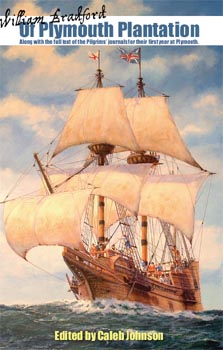Primary Sources
CALEB JOHNSON | HISTORY BOOKS | BIOGRAPHIES | PRIMARY SOURCES | GENEALOGY | CHILDREN | AUDIOBOOKS
The links on this page are affiliate links to Amazon.com and Amazon’s international sites. As an Amazon Associate I earn from qualifying purchases.
The Brewster Book Manuscript
Edited by Caleb Johnson
This manuscript was a blank book that was passed down through the descendants of William Brewster It appears to have been originally a notebook maintained by Mayflower passenger Edward Winslow, that then was used and passed down through Jthe families of onathan2 Brewster and Benjamin3 Brewster. Contains letters, documents, provision lists, family records from 1593 to the late 1800s, and much more. This book includes an image of the original handwritten pages, with a modern-day transcription on page-opposite.
Buy Now
This book is currently only available direct from Lulu.com. Click the links below to buy:
William Bradford’s Of Plymouth Plantation: Along with the full text of the Pilgrims’ journals for their first year at Plymouth.
Edited by Caleb Johnson
This is a modern version of William Bradford’s classic history, Of Plymouth Plantation, with extensive footnotes, and the addition of the Pilgrims’ journals for their first year at Plymouth, often nicknamed “Mourt’s Relation.”
Buy Now
United States
United Kingdom
Canada
Australia
“Mourt’s Relation” is the nickname given to a pamphlet published in 1621, which is essentially a day-to-day journal of the Pilgrims’ exploration of Cape Cod and settling of Plymouth. It is included, in full, in my book above (William Bradford’s Of Plymouth Plantation).
Buy Now:
Good News from New England, by Edward Winslow, continues the journal narrations of “Mourt’s Relation” for another two years, including 1622 and 1623. It focuses on visits to the Wampanoag people and Massasoit.
Buy Now:
Three Visitors to Early Plymouth, contains letters from John Pory, Emmanual Altham, and Isaac Rasieres, who visited Plymouth Colony in 1622, 1623, and 1628 respectively. These letters provide interesting details about Plymouth that are not found in the writings of other colonists.
Buy Now:
These letters are extracted from a partial copy of William Bradford’s letter book, where he made copies of the letters he sent and received. Unfortunately a portion of the manuscript was lost during the Revolutionary War, and the surviving portion was recovered in a fish-market in Nova Scotia in the 1790s. The letters are primarily of a business nature, rather than of a personal nature.
Buy Now:
Thomas Morton was a critic of Plymouth Colony, and in 1637 he wrote a book that includes a dissenting view on the colonists in which he uses satire and characterizations to poke fun at “Captain Shrimip” (Myles Standish), and other Plymouth leaders. He also provides his own personal observations on the flora, fauna, minerals, resources, and Native Americans, of New England, and of the settling of the neighboring Wessagussett Colony.










